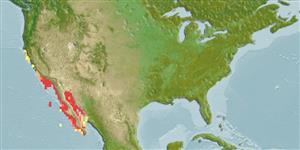Elasmobranchii (haaien en roggen) (sharks and rays) >
Carcharhiniformes (Ground sharks) >
Triakidae (Houndsharks) > Triakinae
Etymology: Mustelus: Latin for weasel, an ancient name for sharks, possibly referring to the pointed snouts, swift movements and/or rapacious feeding behavior of smaller predatory sharks [strictly not tautonymous with Squalus mustelus Linnaeus 1758 since type was designated by the ICZN] (See ETYFish); californicus: -icus (L.), belonging to: California, referring to its common occurrence along the coast of California (USA) (See ETYFish).
More on author: Gill.
Environment: milieu / Klimaatzone / Diepte / distribution range
Ecologie
marien demersaal; diepte 0 - 200 m (Ref. 55308), usually 2 - 46 m (Ref. 55308). Subtropical; 40°N - 23°N, 126°W - 109°W (Ref. 55308)
Eastern Pacific: northern California, USA to the Gulf of California. At the southern part of its range, this species is sympatric with Mustelus lunulatus, but the two are readily distinguishable.
Lengte bij maturiteit / Grootte / Gewicht / Leeftijd
Maturiteit: Lm 78.1, range 85 - ? cm
Max length : 116 cm TL mannelijk / geslacht onbekend; (Ref. 244); 124.0 cm TL (female); max. gerapporteerde leeftijd: 9 Jaren (Ref. 6098)
A common inshore and offshore shark found on the continental shelves, and entering shallow muddy bays. Feeds mostly on crabs, including cancrids and grapsids, ghost shrimp, innkeeper (echiuroid) worms (Urechis), and small fish (herring and midshipmen, Porichthys). Viviparous (with a yolk-sac placenta), with 2 to 5 young in a litter. Utilized for human consumption.
Viviparous with a yolk-sac placenta (Ref. 244).
Compagno, L.J.V., 1984. FAO Species Catalogue. Vol. 4. Sharks of the world. An annotated and illustrated catalogue of shark species known to date. Part 2 - Carcharhiniformes. FAO Fish. Synop. 125(4/2):251-655. Rome: FAO. (Ref. 244)
Status op de Rode Lijst van het IUCN (Ref. 130435: Version 2024-2)
Gevaar voor de mens
Harmless
Gebruik door de mens
Visserij: commercieel; sportvis: ja
Tools
Speciale rapporten
Download XML
Internetbronnen
Estimates based on models
Preferred temperature (Ref.
123201): 15.1 - 23.3, mean 20.9 °C (based on 46 cells).
Fylogenetische diversiteitsindex (Ref.
82804): PD
50 = 0.5000 [Uniqueness, from 0.5 = low to 2.0 = high].
Bayesian length-weight: a=0.00224 (0.00104 - 0.00482), b=3.14 (2.97 - 3.31), in cm total length, based on LWR estimates for this Genus-body shape (Ref.
93245).
Trofisch niveau (Ref.
69278): 3.5 ±0.2 se; based on diet studies.
Generation time: 4.4 ( na - na) years. Estimated as median ln(3)/K based on 2
growth studies.
Weerstandsvermogen (Ref.
120179): Zeer laag, minimale populatieverdubbelingstijd meer dan 14 jaar (K=0.22-0.35; tm=1.3-2.1; tmax=12; Fec=2).
Fishing Vulnerability (Ref.
59153): Moderate to high vulnerability (52 of 100).
🛈
Nutrients (Ref.
124155): Calcium = 20.7 [5.6, 105.3] mg/100g; Iron = 0.522 [0.162, 2.021] mg/100g; Protein = 21.8 [19.4, 24.1] %; Omega3 = 0.139 [0.057, 0.331] g/100g; Selenium = 42.6 [12.0, 151.0] μg/100g; VitaminA = 5.54 [1.87, 15.85] μg/100g; Zinc = 0.595 [0.263, 1.199] mg/100g (wet weight);
